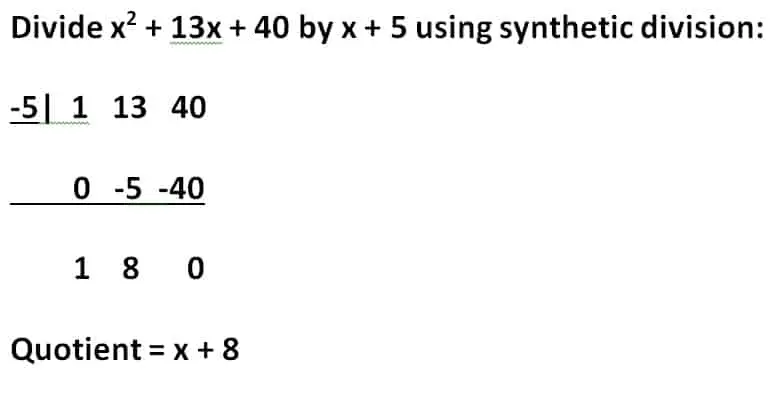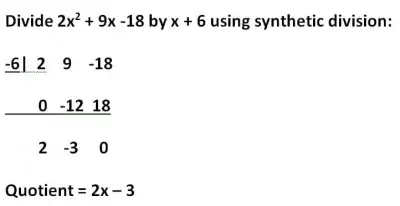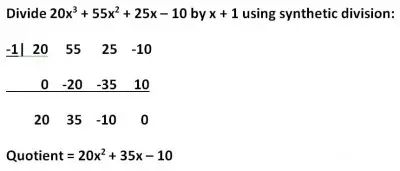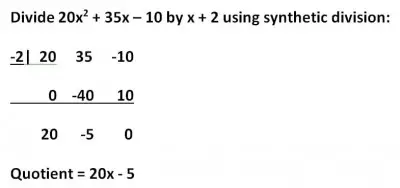Synthetic division can make life easier when you are dividing polynomials. However, it is only useful in certain specific situations, such as when dividing by a linear monic polynomial.
So, can you use synthetic division with a coefficient that is not 1? You need a monic linear divisor to use synthetic division. That means the coefficient of x must be 1. However, you can divide by a linear divisor whose leading coefficient is not 1 if you do it in multiple steps. You can also divide by a quadratic divisor by using synthetic division repeatedly.
Of course, synthetic division is a useful shortcut, but its use is limited by the restriction on the leading coefficient (the coefficient of x must be 1).
In this article, we’ll talk about how to get around this restriction to use synthetic division to divide by a linear polynomial that is not monic. We’ll also look at how to divide by a quadratic divisor by using synthetic division repeatedly.
Let’s get started.
Synthetic Division With A Coefficient That Is Not 1
Remember that synthetic division is used to divide any polynomial by a linear monic polynomial. A linear monic polynomial has the form x + b, where b is a real number (b can be positive, zero, or negative).
Synthetic division is a shortcut for polynomial long division. It helps us to avoid writing variables in the intermediate steps.
However, this raises the question of whether we can use synthetic division with a coefficient that is not 1. The answer is: we can make it work, but we need to break the problem into three steps:
- 1.) Factor the divisor into a product of a constant and a linear monic polynomial. That is, for the divisor ax + b, we would factor it as a(x + b/a).
- 2.) Use synthetic division to divide the dividend polynomial by the linear monic x + b/a. Since the divisor x + b/a has a coefficient of 1, synthetic division will work as usual.
- 3.) Take the result from step 2 and divide the quotient (the resulting polynomial) by a.
These steps will work because dividing by x + b/a and then dividing the result by a is equivalent to dividing by ax + b.
If you are unsure about why this works, think about it this way. If you want to divide a number by 6, you can instead divide it by 2, and then divide the result by 3.
The reason this works is that 6 = 2*3 (2 and 3 are the factors of 6). Let’s see an example:
Example: Dividing By 6 In Two Different Ways
Let’s say we want to divide 120 by 6. First, we’ll divide by 2 and then 3:
- 120 / 2 = 60
- 60 / 3 = 20
So our answer is 20. This is the same answer we get if we just divide by 6: 120 / 6 = 20.
So, dividing 120 by 2 and then dividing the result by 3 is equivalent to dividing by 6.
Let’s look at an example of how this works for a divisor with a coefficient that is not 1.
Example: Synthetic Division When The Coefficient Is Not 1
Let’s say we want to divide x2 + 13x + 40 by 2x + 10.
Following the 3-step process above:
- 1.) First, we factor 2x + 10 as 2(x + 5). [Note that this leaves us with a linear monic polynomial in parentheses – that is, the coefficient of x is 1].
- 2.) Next, we divide x2 + 13x + 40 by x + 5, using synthetic division. This gives us a result of x + 8.
- 3.) Last, we divide the result x + 8 by 2. This gives us a final answer of x/2 + 4.
We can verify this result if we FOIL (2x + 10)(x/2 + 4) to get x2 + 13x + 40.
Below, we see the details of step 2 (synthetic division) in this process:

We can also verify that this works the same way as polynomial long division to give us the correct answer.
Can You Do Synthetic Division With A Fraction?
You can do synthetic division with a fraction if you introduce additional steps, as we outlined above. We still need to factor the divisor so that one of the factors is a linear monic polynomial.
Let’s take a look at an example of how this would work:
Example: Synthetic Division When The Coefficient Is A Fraction
Let’s say we want to divide 2x2 + 9x – 18 by (1/3)x + 2.
Following the 3-step process above:
- 1.) First, we factor (1/3)x + 2 as (1/3)(x + 6). [Note that this leaves us with a linear monic polynomial in parentheses – that is, the coefficient of x is 1].
- 2.) Next, we divide 2x2 + 9x – 18 by x + 6, using synthetic division. This gives us a result of 2x – 3.
- 3.) Last, we divide the result 2x – 3 by 1/3 (division by 1/3 is equivalent to multiplication by 3). This gives us a final answer of 6x – 9.
We can verify this result if we FOIL ((1/3)x + 2)(6x – 9) to get 2x2 + 9x – 18.
Below, we see the details of step 2 (synthetic division) in this process:

We can also verify that this works the same way as polynomial long division to give us the correct answer.
Synthetic Division With A Quadratic Divisor
As we saw earlier, we can use synthetic division with divisors that do not have a leading coefficient on 1. It just takes some extra steps.
The same idea applies to synthetic division with a quadratic divisor. It is possible, but there are some extra steps involved.
The key is that we must use synthetic division repeatedly. Here are the steps:
- 1.) Factor the quadratic divisor into a product of a constant and a quadratic monic polynomial. That is, for the divisor ax2 + bx + c, we would factor it as a(x2 + (b/a)x + (c/a)).
- 2.) Factor the quadratic monic polynomial into a product of two linear monic polynomials. The result will look something like this: a(x – r)(x – s), where r and s are the roots (solutions) of the quadratic.
- 3.) Use synthetic division to divide the dividend polynomial by the linear monic x – r. Since the divisor x – r has a coefficient of 1, synthetic division will work as usual.
- 4.) Take the result from step 3 and divide it by x – s, using synthetic division again.
- 5.) Take the result from step 4 and divide by a.
This is equivalent to dividing by ax2 + bx + c since a(x – r)(x – s) = a(x2 + (b/a)x + (c/a)) = ax2 + bx + c.
Note that in some cases, the quadratic will not factor easily, and you may get complex (imaginary) numbers.
Let’s look at an example of how this works for a quadratic divisor.
Example: Synthetic Division With A Quadratic Divisor
Let’s say we want to divide 20x3 + 55x2 + 25x – 10 by 5x2 + 15x + 10.
Following the 5-step process above:
- 1.) Factor the quadratic divisor into a product of a constant and a quadratic monic polynomial. Here, we factor as: 5x2 + 15x + 10 = 5(x2 + 3x + 2). [Note that this leaves us with a quadratic monic polynomial in parentheses – that is, the coefficient of x2 is 1].
- 2.) Factor the quadratic monic polynomial into a product of two linear monic polynomials. Here, we factor as: 5(x2 + 3x + 2) = 5(x + 1)(x + 2).
- 3.) Use synthetic division to divide the dividend polynomial 20x3 + 55x2 + 25x – 10 by the linear monic x + 1. This gives us a result of 20x2 + 35x – 10.
- 4.) Take the result from step 3 and divide it by x + 2, using synthetic division again. This gives us result of 20x – 5.
- 5.) Take the result from step 4 and divide by a. Here, a = 5, so we get a result of 4x – 1.
We can verify this result if we use the Distributive Property for (5x2 + 15x + 10)(4x – 1) and combine like terms to get 20x3 + 55x2 + 25x – 10.
Below, we see the details of steps 3 and 4 (synthetic division) in this process:


Conclusion
Now you know how to do synthetic division with a linear polynomial divisor whose lead coefficient is not 1. You also know how to do synthetic division with a quadratic divisor by using synthetic division repeatedly.
I hope you found this article helpful. If so, please share it with someone who can use the information.
Don’t forget to subscribe to my YouTube channel & get updates on new math videos!
~Jonathon


